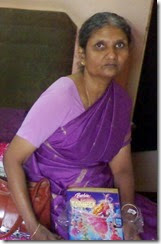PARAKEETS
 |
| (C) Birdden |
Parakeets are also called the Australian Parrots belonging to broad-tailed parrots and they have been in existence on this earth for nearly 5 million years. Parakeets are usually 18cm long weighing 30 to 40 g. Usually the wild varieties are green in colour with a small change in colour at the back (mantle) and wings which are black edged in yellow. The actual colour or plumage of the parakeet comes into vicinity when they are old enough after 3-4 months of age. the parakeets have zygodactyl toes with olive grey beaks and bluish-grey legs. Generally parakeets are smaller in size than parrots but when bred in captivity they can become beautiful and grow bigger than normal size. Some of the other colours in captivity are white, blue and purple while blue, green, yellow and white is also available. They fluoresce in UV radiation especially during mating season and this is a characteristic feature that the opposite gender uses for selecting their choice of mate. The colour of the cere (the nostril region) is usually royal blue in males and is from pale-brown to white or brown in both the sexes. in juveniles this is pink in colour.
 |
| (C) birdlife |
 |
| (c) Australiawonderfulbirds |
 |
| (c) petguide |
Male Versus Female: Parakeet male birds coexist with mutual understanding but not female birds. However, when female birds are kept together they usually land up fighting. However, in pairs they are much happier and are easy to tame in contrast to other birds, including parrots.
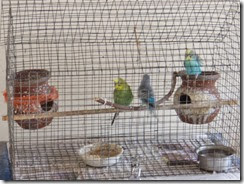
Habitat and Nurturing Parakeets: Parakeets usually are seen in the wild as wanderers in open grasslands and woodlands. They usually live in flocks feeding on seeds, spinifex, grass weeds and wheat from the fields. They love to preen themselves which might become a habit in captivity. Parakeets are excellent and intelligent companions and in Indian mythology “Parrot” was considered to be the best friend of Goddess Meenakshi, Madurai, Tamil Nadu. 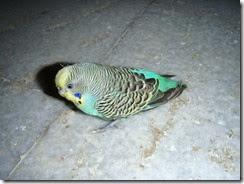
At home you can make your little greeny comfortable in a rectangular cage by spreading paper towels or tissue paper, but I would suggest from my personal experience newspaper or magazine paper for they have the habit of tearing them into pieces. Decorate and bring to life the cage with perches (my mom used pressure cooker gasket and CD to keep them engaged), water and food dishes, besides toys. Some of the suggested toys for parakeets are those with bells, trucks where they can perch and peck, spinning toys, toys that move with touch and toys made of paper and soft wood. The cage should be kept in a place which is least disturbed and from where they can enjoy soft music with you. This is difficult to have a parakeet with you for one need to really take care of them, but they get habituated to you changing water and food; and if you forget one day to fill their food day – not to worry they will come to the door to call you and ask for food.
The best food for parakeets are seeds and bird food; besides fresh vegetables like parsley leaves, mint, coriander leaves, kale, beets, peas, carrots, parsleys, cooked yams, sliced apples, mandarin oranges and citrus – all chopped into small slices using a food processor and dispersed into their little bowls. Food to avoid to be given to parakeets which otherwise will make them sick are: canned veggies, non-organic fruits or veggies, avocados, eggplant, rhubarb, potato and tomato leaves, bean plant leaves, apple seeds, alcohol, coffee and tea, chocolate, apricot, cherry, peach, pear and plum seeds, peanut and gravel.
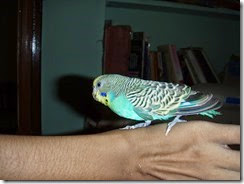 Time is the most important criteria that you can give your little ones so that they will feel at home and one among you. The best way to tame and pamper the little birds is to keep talking to them, feeling them, patting them and allowing them to climb over your fingers and peck. Once you tame one of the birds in the cage, the rest of them are automatically nudged by the rest of the birds to be pampered. They are better friends, intelligent observers and talk to you when you come back home. This is no scrap to do with God; just reverting the love and care that you give them.
Time is the most important criteria that you can give your little ones so that they will feel at home and one among you. The best way to tame and pamper the little birds is to keep talking to them, feeling them, patting them and allowing them to climb over your fingers and peck. Once you tame one of the birds in the cage, the rest of them are automatically nudged by the rest of the birds to be pampered. They are better friends, intelligent observers and talk to you when you come back home. This is no scrap to do with God; just reverting the love and care that you give them.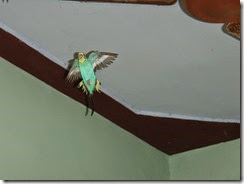
Parakeets should be allowed to fly within confined spaces to give them some exercise and keep them active and healthy. Weight loss and weight gain are two major problems of parakeets in confinement. Measuring them regularly is very important, and of course not all of us bother much but when enough exercise is given, this becomes unimportant. Parakeet shows signs of illness which could be observed from their droppings, vomiting and swooping down on the cage floor. they stop flying and prefer sitting, of course my nephew’s parakeet likes to perch on me and get pampered, which when it keeps pecking, which is not a sign of illness. One will notice fatigue in them.
 |
| (c)steemit |
Talking Parakeets: Parakeets learn to sing and make sounds like how we speak to them while pampering. This has got nothing to do with Amman or any other superstitious beliefs. They mimic people who spend and interact more with them. In fact, male parakeets are much easier to tame and quick to learn than female parakeets.
LOVE BIRDS
Love birds also belong to the family of parrots but are much more smaller than parakeets. Love birds are much more sociable and affectionate to the owners. These birds are native to African continent and Madagascar. These birds are so named because they prefer to have monogamous relationships and live in pairs for a long time. The pair likes to spend time together for hours and when the bonding breaks the lifetime of the birds decreases. Though found in pairs, pairs remain together in flocks.
 |
| (C) biologydictionary |
Species: There are 9 species in love birds. The common domestic love birds are peach-faced, fisher and masked. These birds usually weighs around 50-55 gm and live for nearly 8 to 10 years reaching a maximum of 15 years.
 |
| (C) birdscoo |
 |
| (C) flickr |
Peach-faced love birds are the most popular ones and are highly tamed, independent and friendly birds owing to their remarkable intelligence. These are the most beautiful of the lot coming in vivid colours like light red-face, blue rumps, grey feet with a brightly coloured beak. The eyes have a white halo. Some of the variations of these birds include cream, orange faced, white faced blue, lutino, blue pied dilute, cinnamon and fallow.
 |
| (C) ebird |
Fischer’s love birds are one of the smallest birds with the most brilliant variations in colours. The face which is usually bright red in colour for the male bird in particular, which is somewhat orange tint in female and also dulls out as orange as it goes down from face to throat and while reaching the breast is yellowish-orange in colour and has a smart green body colour. These birds have blue rump and orange and black traces on their wings. While as usual the feet and legs are grey and the beak is red in colour. Other common colour variations in these birds will include black or dark eyed white colour bird, dilute blue and yellow, cinnamon, Lutino and albino.
 |
| (C) pbase |
Black-masked love birds are the second most popular types of birds next to peach-faced. These birds are marketed for their wonderful brilliant colour contrasts like dark factor, blue, dilute and pied. these are one of the most noisiest birds that keeps chirping throughout the day, especially at high-pitch during dawn and dusk.
Food: They eat grasses, fruits, vegetables and seeds. Black species of love birds are omnivores in a sense that they also feed on figs and small insects.
Love birds lay nearly 4 to 6 eggs and is the female which plays a major role in building and preparing the nest and hatching of eggs.
Taming Love Birds: These gentle yet boisterous birds are often called “Pocket Parrots”. They are capable of mimicking human voices to a certain extent, especially of those who are closer to them, unfortunately are good as “talking parrots”. If you are looking for a bird to talk then these are not of your choice. However if you are looking for someone who will adore you like a dog or a cat and yet you can leave them inside your house for a holiday with a bowl full of seeds and water, then these are the best pets. However, your absence will make them aggressive, still you can pamper them back to normal by giving more time than usual. Sounds human indeed! One of the main problem in having these love birds is that they are much prone to feather picking if you leave them unnoticed. As these birds are quite used to chew the barks of woods in nature, this is advisable that you get them toys that are chewable especially those made of soft wood and of course, there is no better toy than their dropped feathers.


